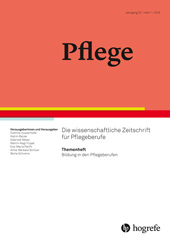Nursing professionals’ attitudes toward use of physical restraints in Styrian nursing homes Austria
Abstract
Abstract.Background: Given that nursing staff play a critical role in the decision regarding use of physical restraints, research has examined nursing professionals’ attitudes toward this practice. Aim: Since nursing professionals’ views on physical restraint use have not yet been examined in Austria to date, we aimed to explore nursing professionals’ attitudes concerning use of physical restraints in nursing homes of Styria (Austria). Method: Data were collected from a convenience sample of nursing professionals (N = 355) within 19 Styrian nursing homes, based on a cross-sectional study design. Attitudes toward the practice of restraint use were assessed by means of the Maastricht Attitude Questionnaire in the German version. Results: The overall results showed rather positive attitudes toward the use of physical restraints, yet the findings regarding the sub-dimensions of the questionnaire were mixed. Although nursing professionals tended to deny “good reasons” for using physical restraints, they evaluated the consequences of physical restraint use rather positive and considered restraint use as an appropriate health care practice. Nursing professionals’ views regarding the consequences of using specific physical restraints further showed that belts were considered as the most restricting and discomforting devices. Conclusions: Overall, Austrian nursing professionals seemed to hold more positive attitudes toward the use of physical restraints than counterparts in other Western European countries. Future nationwide large-scale surveys will be needed to confirm our findings.
Zusammenfassung.Hintergrund: Da den Pflegekräften eine bedeutende Rolle bezüglich der Entscheidung zur Anwendung freiheitsbeschränkender Maßnahmen zukommt, wurden deren Einstellungen zu dieser Praxis vielfach untersucht. Ziel: Vergleichbare Daten für Österreich liegen derzeit jedoch nicht vor, weshalb die vorliegende Studie die Einstellungen von Pflegekräften zur Verwendung freiheitsbeschränkender Maßnahmen in steirischen Pflegeheimen untersucht. Methode: Die erhobenen Daten stammen aus einer Gelegenheitsstichprobe von Pflegekräften (N = 355) aus 19 steirischen Pflegeheimen. Die Einstellungen der Pflegekräfte wurden mit Hilfe der deutschen Version des „Maastricht Attitude Questionnaire“ in einem Querschnittsdesign erhoben. Ergebnisse: Die Ergebnisse zeigten eher positive, wenn auch teilweise widersprüchliche Einstellungen der Pflegekräfte gegenüber dieser Praxis. Obwohl die Pflegekräfte wenig „gute Gründe“ für die Verwendung freiheitsbeschränkender Maßnahmen angaben, wurden diese als eine angemessene Intervention in der Pflege beurteilt. Die Einschätzungen der Pflegekräfte im Hinblick auf die Wirkung der unterschiedlichen Maßnahmen deuten darauf hin, dass Gurte als die am stärksten einschränkenden und am meisten Unbehagen auslösenden Maßnahmen gesehen werden. Schlussfolgerungen: Österreichische Pflegekräfte scheinen eine etwas positivere Einstellung gegenüber der Anwendung freiheitsbeschränkender Maßnahmen zu haben, als Pflegekräfte in anderen westeuropäischen Ländern. Weitere überregionale österreichische Untersuchungen werden gefordert, um die Ergebnisse dieser Studie zu bestätigen.
References
(2017). Physical restraint deaths in a 13-year national cohort of nursing home residents.
Age and Ageing , 46 (4), 688 – 693.(2012). Deaths due to physical restraint.
Deutsches Ärzteblatt International , 109 (3), 27 – 32.BGBl I No 59 . (2017).Austrian Nursing Home Residence Act. Austria: Austrian Federal Chancellery . www.ris.bka.gv.at/Geltende Fassung.wxe?Abfrage=Bundesnormen&Gesetzesnummer=20003231 [3.12.2017].(2012). Maastricht Attitude Questionnaire, English version. Maastricht: Maastricht University.
; International Physical Restraint Workgroup. (2016). Physical restraints: Consensus of a research definition using a modified delphi technique.
Journal of the American Geriatrics Society , 64 (11), 2307 – 2310.(2009). The health consequences of using physical restraints in nursing homes.
Medical Care , 47 (11), 1164 – 1173.(2006). Use of physical restraint in nursing homes: Clinical-ethical considerations.
Journal of Medical Ethics , 32 (3), 148 – 152.(2012). Nurses’ decision-making in cases of physical restraint: A synthesis of qualitative evidence.
Journal of Advanced Nursing , 68 (6), 1198 – 1210.(2013). International prevalence measurement of care problems: Results.
Journal of Advanced Nursing , 69 (9), e5 – 17.(2004). Use of physical restraints with cognitively impaired nursing home residents.
Journal of Advanced Nursing , 45 (3), 246 – 251.(2005a). The use of physical restraints in elderly people: nurses’ Attitudes. Abstractbook 18th congress of the International Association of Gerontology and Geriatrics. Rio de Janeiro, Brazil. June 26 – 30.
(2005b). Why do we use physical restraints in the elderly?
Zeitschrift für Gerontologie und Geriatrie , 38 (1), 19 – 25.(2009). Attitudes of Dutch, German and Swiss nursing staff towards physical restraint use in nursing home residents, a cross-sectional study.
International Journal of Nursing Studies , 46 (2), 248 – 255.(2013). Prävalenz von freiheitsbeschränkenden Maßnahmen in österreichischen Alten- und Pflegeheimen.
Österreichische Pflegezeitschrift , 5/2013, 25 – 29.(2015). Use of physical restraints in nursing homes: A multicentre cross-sectional study.
BMC Geriatrics , 15. doi: 10.1186/s12877-015-0125-x(2006). Restraint removal: Tension between protective custody and human rights.
International Journal of Older People Nursing , 1 (3), 151 – 158.(2012). Effect of a guideline-based multicomponent intervention on use of physical restraints in nursing homes: A randomized controlled trial.
JAMA , 307 (20), 2177 – 2184.(2017). Educational intervention on physical restraint use in long-term care facilities – Systematic review and meta-analysis.
The Kaohsiung Journal of Medical Sciences , 33 (8), 411 – 421.(2006). Physical restraints: Attitudes of nursing staff and prevalence in state-run geriatric institutions in the city of Luzern. Maastricht University, Maastricht, Unpublished Master Thesis.
(2014). Attitudes of nurses towards the use of physical restraints in geriatric care: A systematic review of qualitative and quantitative studies.
International Journal of Nursing Studies , 51 (2), 274 – 288.(2012). Interventions for preventing and reducing the use of physical restraints in long-term geriatric care – A Cochrane review.
Journal of Clinical Nursing , 21, 3070 – 3081.R Core Team . (2017). R: A Language and Environment for Statistical Computing.R Foundation for Statistical Computing , Vienna, Austria. www.R-project.org(2013). Morbidity and mortality associated with the utilization of restraints.
Psychiatric Quarterly , 84 (4), 499 – 512.



